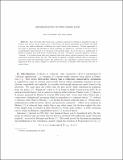Files in this item
Geometrisation of first-order logic
Item metadata
| dc.contributor.author | Dyckhoff, Roy | |
| dc.contributor.author | Negri, Sara | |
| dc.date.accessioned | 2015-06-12T12:10:01Z | |
| dc.date.available | 2015-06-12T12:10:01Z | |
| dc.date.issued | 2015-06 | |
| dc.identifier | 181704500 | |
| dc.identifier | dbf76454-5fcd-4d56-8269-69f62f7dcd21 | |
| dc.identifier | 84962091019 | |
| dc.identifier | 000355799500002 | |
| dc.identifier.citation | Dyckhoff , R & Negri , S 2015 , ' Geometrisation of first-order logic ' , Bulletin of Symbolic Logic , vol. 21 , no. 2 , pp. 123–163 . https://doi.org/10.1017/bsl.2015.7 | en |
| dc.identifier.issn | 1079-8986 | |
| dc.identifier.uri | https://hdl.handle.net/10023/6818 | |
| dc.description.abstract | That every first-order theory has a coherent conservative extension is regarded by some as obvious, even trivial, and by others as not at all obvious, but instead remarkable and valuable; the result is in any case neither sufficiently well-known nor easily found in the literature. Various approaches to the result are presented and discussed in detail, including one inspired by a problem in the proof theory of intermediate logics that led us to the proof of the present paper. It can be seen as a modification of Skolem’s argument from 1920 for his “Normal Form” theorem. “Geometric” being the infinitary version of “coherent”, it is further shown that every infinitary first-order theory, suitably restricted, has a geometric conservative extension, hence the title. The results are applied to simplify methods used in reasoning in and about modal and intermediate logics. We include also a new algorithm to generate special coherent implications from an axiom, designed to preserve the structure of formulae with relatively little use of normal forms. | |
| dc.format.extent | 41 | |
| dc.format.extent | 519068 | |
| dc.language.iso | eng | |
| dc.relation.ispartof | Bulletin of Symbolic Logic | en |
| dc.subject | Coherent implication | en |
| dc.subject | Coherent logic | en |
| dc.subject | Geometric logic | en |
| dc.subject | Weakly positive formula | en |
| dc.subject | QA75 Electronic computers. Computer science | en |
| dc.subject | QA Mathematics | en |
| dc.subject | NDAS | en |
| dc.subject.lcc | QA75 | en |
| dc.subject.lcc | QA | en |
| dc.title | Geometrisation of first-order logic | en |
| dc.type | Journal article | en |
| dc.contributor.institution | University of St Andrews. School of Computer Science | en |
| dc.contributor.institution | University of St Andrews. Centre for Interdisciplinary Research in Computational Algebra | en |
| dc.identifier.doi | 10.1017/bsl.2015.7 | |
| dc.description.status | Peer reviewed | en |
| dc.identifier.url | http://www.math.ucla.edu/~asl/bsltoc.htm | en |
This item appears in the following Collection(s)
Items in the St Andrews Research Repository are protected by copyright, with all rights reserved, unless otherwise indicated.

